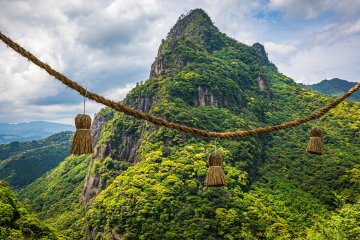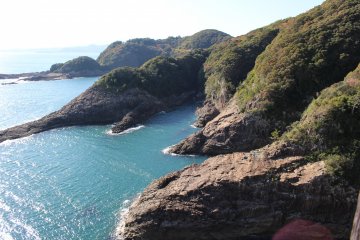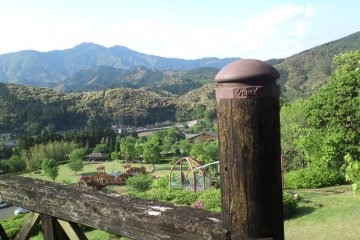Nobeoka City in Miyazaki, Kyushu, is a popular destination for outdoor activities featuring its mountains and rivers. These mountains and rivers can also be enjoyed within Noboeka City. Nobeoka's Mount Ima houses two Shrines as well as the Nobeoka Castle ruins with its historic bell landmark. The Rivers Gokase and Ose are an unmissable presence, good to look at and be around.

Nobeoka's two shrines are Imayama Daishi and Imayama Hachiman Jingu. Imayama Daishi draws devotees of Kobo Daishi (774-835), a Buddhist Monk attributed with the founding of the Shingon School of Japanese Buddhism. His statue here at 17 metres is Japan's tallest.

The Shrine is reached through a long and steep avenue of steps and stone lanterns. The two tier gateway is a red lacquered affair, with plentiful jizo of various ages and sizes dispersed around the grassy slopes. Together with comrades like the Seven Lucky Gods and Kannon, they augment the shrine’s spiritual atmosphere.
Two lion dogs or komainu guard like hawks the nearby Imayama Hachimangu Shrine with its red two tier entrance. Hachimangu is Nobeoka’s oldest Buddhist temple, built in the year 717, consecrated with 14 deities venerated as the Guardians of Nobeoka. These are worshipped in the numerous shrines a bit scattered around the rather large grounds. There are two biggish shrines, one red, the other creamy beige, then a small shrine with red torii gates to pray to the Fox Gods or Inari, then a Konpira, for safe sea-faring. There is a bit of a desolate air about the place.

The walk looking for the two Imayamas passes through archways of forested overhanging trees that make up Shiroyama Hill and Park. Nobeoka’s Castle ruins and Bell are here.

The ruins are testimony to the Japanese value of conservation, where ancient remnants are still treasured, and recreated painstakingly and accurately. An impressive large section of the Castle Wall, the Honmaru, the main section of Japanese castles, and the Bell Tower, are still proudly intact. The main gate or Otemon, reconstructed in 1993, overlooks a sealed off section of historic graves. These ruins once mattered. The Park is today peaceful, but its history is bloody, once the locale for a key battle during the Meiji Restoration.
The large bronze Bell and its tower are very much alive, visibly and audibly. Since 1878, volunteer bell keepers ring the bell six times a day, from 6 am - 5 pm. The bell keeper performs with precision the rituals that begin with untying the loosely swinging pole from its chains, controlling it into position, then knowing the exact time it takes to pull the pole behind him, so it will hit the bell on the dot of the hour. He wore no watch. He hardly moves. The Bell today is the second replica of the original at Nobeoka’s Naito Museum.

The view from the Bell Tower is a vantage point to view Nobeoka city cut across by its rivers, with mountains layered in the background. We can walk into this view from anywhere along the rivers, from any where in town. It’s an engaging riverine walk, almost endless as the Gokase stretches for 106 km. Time passes looking at the clear reflections in the water, the embankments of thick vegetation that splits the Gokase into its tributary the Ose, tiny tumbles of sacred monuments on the river side, old residences. Nobeoka was built on the Gokase’s delta. Its origins date to the 12th century, when it was known as “The Capital Of Water”, and today the “City of Rivers”.

Nobeoka is walkable from its station, a cheerful hub, with most of its ground floor and upper floor a bookshop, with coffee and free wifi.
Maybe Nobeoka is like many other Japanese towns. So it’s actually being inside Japan.















